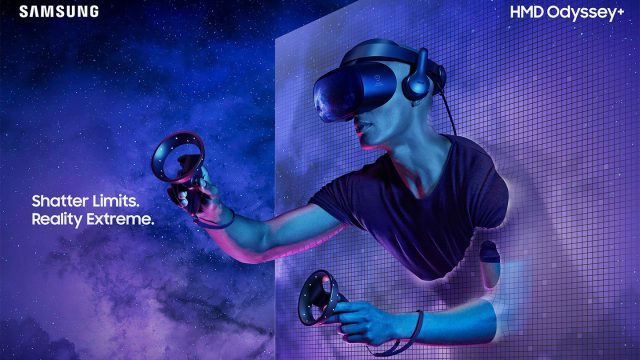Back in August we uncovered what appeared to be an updated version of Samsung’s Odyssey Windows VR headset. Now a listing on Samsung’s official website confirms the Odyssey+ and its price, suggesting that a launch is soon at hand.
Update (October 22nd, 2018 – 10:52PM PT): A press release from Samsung today serves as the official announcement of the Odyssey+ and confirms availability in the US starting today from Samsung and Microsoft. The headset will be available “soon” in Korea, China, Hong Kong, and Brazil. To the dismay of enthusiasts, Samsung didn’t sell the prior iteration of the Odyssey in Europe, and the Odyssey+ seems destined for the same.
Beyond the details already gleaned from the headset’s product page, the announcement confirms that the headset has built in Bluetooth, meaning that the controllers will connect directly to the headset instead of relying on the host PC’s own Bluetooth connection (which required an additional dongle in the case of most desktop PCs). The controllers are “pre-paired” out of the box, Samsung says, making setup a bit easier still.
The announcement also indicates that the anti-SDE technology is “exclusive” to the Odyssey+. Samsung supplies displays to other VR headsets like the Rift and Vive, and this particular line makes it sound like the company plans to keep the anti-SDE diffuser for their own headsets.
Original Article (October 22nd, 2018): Spotted by Reddit user MasterTentacles, a listing on Samsung’s Hong Kong website shows the consumer-facing listing for the Odyssey+ Windows VR headset. We found the corresponding US listing for the headset, which confirms a $500 price, the same as the original Odyssey.
Despite the listing, Samsung has yet to officially announce the headset or a release date. Although there’s a ‘Where to Buy’ button on the product page, no retailers are listed; it’s unclear when the headset will become available for purchase.
In addition to the price, the Odyssey+ product page reveals some interesting details. The headset has what Samsung calls an “Anti-SDE” display. It’s the same 1,440 × 1,600 (per eye) resolution as the original headset, but “effectively delivers over twice the pixel count,” according to Samsung. Fine print further specifies this claim (though not quite to our satisfaction):
Samsung Anti-SDE AMOLED Display solves SDE by applying a grid that diffuses light coming from each pixel and replicating the picture to areas around each pixel. This makes the spaces between pixels near impossible to see. In result, your eyes perceive the diffused light as part of the visual content, with a perceived PPI of 1,233PPI, double that of the already high 616PPI of the previous generation Samsung HMD Odyssey+ [sic].
It sounds like Samsung has embedded the displays with a diffuser which is designed to let light spill into the the unlit gaps between pixels, thereby hiding the screen door effect. We believe PSVR has used the same approach to great effect.
However, Samsung’s claim that it doubles “user-perceived resolution” sounds misleading. The diffuser may reduce the screen door effect to a point that it looks similar to what would be seen from a display with twice the pixel density, but as far as we can tell, the perceived sharpness of the display (the aspect most associated with resolution) cannot be increased with this method. Hopefully Samsung will offer more specificity about what their anti-SDE tech does in the near future.
Aside from the anti-SDE display, the Odyssey+ also boasts improved ergonomics. In particular, Samsung notes that the nose guard has been widened to 40mm (from 32mm), and that the facial interface has been widened to 146mm (from 138mm). Both changes could help the headset fit more faces, and might make it easier to fit glasses inside. Samsung also says that new foam padding will make the headset more comfortable and help prevent fogging of the lenses.
It seems likely that Samsung will want to launch the Odyssey+ ahead of the holidays. The company’s developer conference coming up at the beginning of November seems like a likely time to do so, if not sooner.



